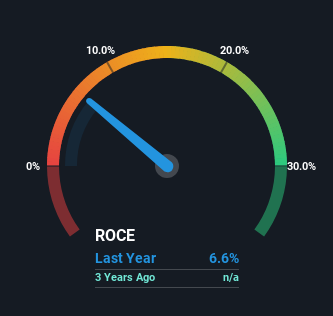If we want to find a stock that could multiply over the long term, what are the underlying trends we should look for? Ideally, a business will show two trends; firstly a growing return on capital employed (ROCE) and secondly, an increasing amount of capital employed. This shows us that it's a compounding machine, able to continually reinvest its earnings back into the business and generate higher returns. However, after investigating OCI (KRX:456040), we don't think it's current trends fit the mold of a multi-bagger.
What Is Return On Capital Employed (ROCE)?
For those that aren't sure what ROCE is, it measures the amount of pre-tax profits a company can generate from the capital employed in its business. To calculate this metric for OCI, this is the formula:
Return on Capital Employed = Earnings Before Interest and Tax (EBIT) ÷ (Total Assets - Current Liabilities)
0.066 = ₩111b ÷ (₩2.3t - ₩612b) (Based on the trailing twelve months to December 2024).
So, OCI has an ROCE of 6.6%. Even though it's in line with the industry average of 7.1%, it's still a low return by itself.
View our latest analysis for OCI

Historical performance is a great place to start when researching a stock so above you can see the gauge for OCI's ROCE against it's prior returns. If you're interested in investigating OCI's past further, check out this free graph covering OCI's past earnings, revenue and cash flow.
What The Trend Of ROCE Can Tell Us
In terms of OCI's historical ROCE trend, it doesn't exactly demand attention. The company has consistently earned 6.6% for the last one year, and the capital employed within the business has risen 48% in that time. This poor ROCE doesn't inspire confidence right now, and with the increase in capital employed, it's evident that the business isn't deploying the funds into high return investments.
One more thing to note, even though ROCE has remained relatively flat over the last one year, the reduction in current liabilities to 27% of total assets, is good to see from a business owner's perspective. This can eliminate some of the risks inherent in the operations because the business has less outstanding obligations to their suppliers and or short-term creditors than they did previously.
The Bottom Line
Long story short, while OCI has been reinvesting its capital, the returns that it's generating haven't increased. And investors appear hesitant that the trends will pick up because the stock has fallen 33% in the last year. All in all, the inherent trends aren't typical of multi-baggers, so if that's what you're after, we think you might have more luck elsewhere.
OCI does have some risks though, and we've spotted 1 warning sign for OCI that you might be interested in.
If you want to search for solid companies with great earnings, check out this free list of companies with good balance sheets and impressive returns on equity.
New: AI Stock Screener & Alerts
Our new AI Stock Screener scans the market every day to uncover opportunities.
• Dividend Powerhouses (3%+ Yield)
• Undervalued Small Caps with Insider Buying
• High growth Tech and AI Companies
Or build your own from over 50 metrics.
Have feedback on this article? Concerned about the content? Get in touch with us directly. Alternatively, email editorial-team (at) simplywallst.com.
This article by Simply Wall St is general in nature. We provide commentary based on historical data and analyst forecasts only using an unbiased methodology and our articles are not intended to be financial advice. It does not constitute a recommendation to buy or sell any stock, and does not take account of your objectives, or your financial situation. We aim to bring you long-term focused analysis driven by fundamental data. Note that our analysis may not factor in the latest price-sensitive company announcements or qualitative material. Simply Wall St has no position in any stocks mentioned.
About KOSE:A456040
OCI
Engages in the manufacture and sell polysilicon, carbon black, and related products.
Moderate risk second-rate dividend payer.
Market Insights
Community Narratives




